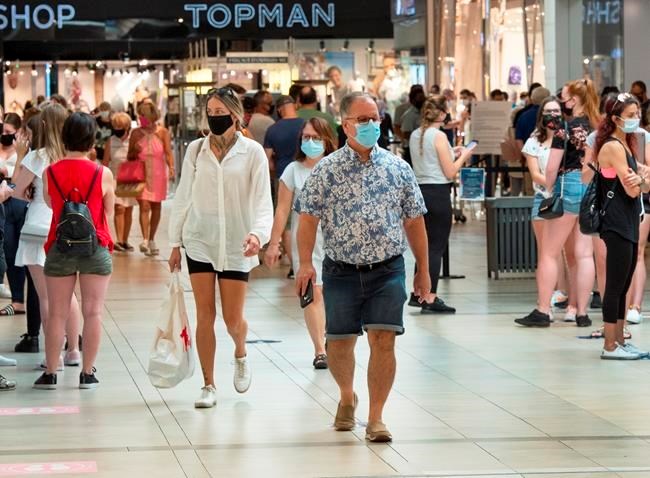Retail sales are on pace to recover from the COVID-19 shutdowns after surging nearly 19 per cent in May with even larger gains expected in June, says Statistics Canada.
The agency says retail sales increased to $41.8 billion in May after steep declines in the previous two months, still leaving them 20 per cent below levels in February, before physical distancing measures were implemented to fight COVID-19.
Economists on average had expected an increase in May of 20 per cent, according to financial markets data firm Refinitiv.
Excluding the automotive sector, sales increased 10.6 per cent.
The results showed there's a lot of pent-up demand in the economy, said Dawn Desjardins, deputy chief economist for the Royal Bank of Canada.
StatCan said about 23 per cent of retailers were closed during the month, with the average shutdown lasting five business days.
"We know April was a very difficult month for our economy, in particular for retailers, and we did see this recovery start in May. I think it corresponds with some reopening in some parts of the economy and so it was a broadly based increase and so largely in line with what people were thinking," she said in an interview.
Sales activity is about 80 per cent recovered from two months of sharp declines including 24.1 per cent in April, with StatCan suggesting another 24.5 per cent increase for June.
"That will put it really back in line with where it was in June 2019, so moving up to the positive side from a very deep decline that we saw in April."
Sales were up in 10 out of 11 subsectors with vehicle and parts dealers, general merchandise stores and clothing stores the main contributors to May's strength.
Motor vehicle and parts dealer sales soared 66 per cent, up for the first time in three months to nearly $8.5 billion; clothing and accessories rose 92.6 per cent to $932 million; sporting goods, book and music jumped 101.2 per cent to $750 million; furniture increased 58.6 per cent to $947 million; and general merchandise gained 20.4 per cent to $6.5 billion.
Gasoline stations were up 17.1 per cent to $3.3 billion after a record 35.5 per cent decrease in April. Electronics and appliance stores climbed 12.1 per cent to $1.1 billion, building materials and garden equipment increased 5.5 per cent to $2.9 billion and cannabis stores rose 4.2 per cent to a record $186 million.
Food and beverage stores were the only subsector to decrease, losing two per cent to $11.8 billion as supermarket sales fell 4.2 per cent and beer, wine and liquor store sales were down 1.2 per cent.
While auto sales crashed in the couple of months after the COVID lockdowns, a survey by CarGurus suggests the delayed sales aren't lost as shoppers.
Some 86 per cent of respondents say they delayed their purchases but more than two-thirds are actively researching and only six per cent have parked their plans indefinitely.
Interest in buying online has grown during the pandemic, doubling to 62 per cent.
All provinces and territories contributed to the sales increase but the recovery was strongest in Quebec where sales grew 33.3 per cent, followed by Newfoundland and Labrador at 25.5 per cent and Manitoba at 24 per cent. Ontario sales were the largest at $14.3 billion, up 14.2 per cent following a 30.9 per cent decrease in April.
Statistics Canada says online sales were $3.8 billion in May, accounting for eight per cent of the total retail market. Retail e-commerce sales increased 112.7 per cent from a year earlier.
Spending activity was supported by job creation in May and income support programs from government, said Desjardins.
But it's been a significant strain on some companies that have been forced to seek creditor protection as consumers held back spending which accounts for more than half of the economic output.
"It's very important that the consumer continues to spend. As we go forward that rapid pace of recovery that we're seeing, there's chances that that won't be sustained and the reason will be because we are opening up the economy but some jobs won't be coming back in the near term, simply because of the physical distancing rules that have to remain in place."
Desjardins also said that the tapering off of income support programs and easing up of payment deferrals may prompt a change in consumer behaviour.
"Consumers may be a little more cautious, so we probably won't see this huge spurt in activity being sustained as we go through the latter part of this year."
This report by The Canadian Press was first published July 21, 2020.
Ross Marowits, The Canadian Press



